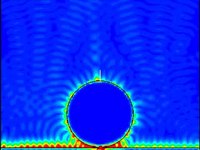
Photo from wikipedia
Abstract In discontinuous Galerkin time domain method (DGTD), the computational region is divided into multiple subdomains instead of using a single mesh for the multiscale structure in finite-difference time-domain (FDTD)… Click to show full abstract
Abstract In discontinuous Galerkin time domain method (DGTD), the computational region is divided into multiple subdomains instead of using a single mesh for the multiscale structure in finite-difference time-domain (FDTD) method. Accordingly, electrically coarse structures are modeled by hexahedral elements with higher interpolation degrees, while electrically fine structures with complex shapes are spatial discretized by tetrahedral elements with lower interpolation degrees. A nonconforming mixed-element DGTD method is implemented to simulate transient electromagnetic response of general 3-D targets in this paper. Perfectly matched layer (PML) boundary condition is utilized to simulate the propagation of electromagnetic waves in infinite space. PML is formulated by auxiliary differential equation with transformed field variables E and H. The numerical flux is employed to communicate fields between adjacent subdomains including physical region and PML region. The accuracy and efficiency of the proposed method is demonstrated by several numerical experiments.
Journal Title: Optik
Year Published: 2021
Link to full text (if available)
Share on Social Media: Sign Up to like & get
recommendations!